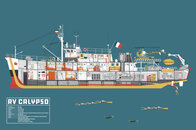The work is being done in Turkey as there a number of specialised carpenteers, still used on working on wood shells, ara available.
That is a major issue. My grandfather was a shipwright at yards in San Francisco. I regret that I didn't pay more attention to his work when I had the chance. He learned the trade on a small island east of Trieste Italy before migrating to to the US. He did learn to work with plywood but there wasn't much call for it after World War II since everyone knew those boats had a limited life. Thankfully, he retired just before the wood boat builders shut down or switched to fiberglass or metal.
It is definitely a lost art in the US today for vessels anywhere near Calypso's size -- even though she was build here. It is very hard to obtain the quality of wood required even if the skills and large steam bending facilities were available. Not many naval architects here could detail it on their 3D CAD programs and you can't download CNC programming to eShipwright machinery.




